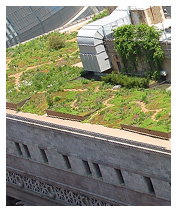How Chicago is Preparing for a “Permanent Heat Wave”
The Chicago Climate Action Plan aims to mitigate shocking forecasts that the northern city is on pace to end up with summers like those in the U.S.’s Deep South, with as many as 72 days over 90 degrees before the end of the century, up from an average of fewer than 15.
The city of Chicago, listening to climate scientists who say that it’s on track for a much hotter future in the coming decades, is making changes.
According to “A City Prepares for a Warm Long-Term Forecast,” in the New York Times last month:
 “Public alleyways are being repaved with materials that are permeable to water. The white oak, the state tree of Illinois, has been banned from city planting lists, and swamp oaks and sweet gum trees from the South have been given new priority. Thermal radar is being used to map the city’s hottest spots, which are then targets for pavement removal and the addition of vegetation to roofs.”
“Public alleyways are being repaved with materials that are permeable to water. The white oak, the state tree of Illinois, has been banned from city planting lists, and swamp oaks and sweet gum trees from the South have been given new priority. Thermal radar is being used to map the city’s hottest spots, which are then targets for pavement removal and the addition of vegetation to roofs.”
“Cities adapt or they go away,” said Aaron N. Durnbaugh, deputy commissioner of Chicago’s Department of Environment.
Chicago launched the Chicago Climate Action Plan in September 2008. The plan’s website, at www.chicagoclimateaction.org, includes details about the predictions, a progress report from the first two years, and ways for companies to participate.
“The forecasts, while not out of line with global predictions, shocked city planners,” says the Times story. “If world carbon emissions continued apace, the scientists said, Chicago would have summers like the Deep South, with as many as 72 days over 90 degrees before the end of the century. For most of the 20th century, the city averaged fewer than 15. By 2070, Chicago could expect 35 percent more precipitation in winter and spring, but 20 percent less in summer and fall. By then, the conditions would have changed enough to make the area’s plant hardiness zone akin to Birmingham, Ala.”
Chicago’s effort began in 2006, when the then-mayor, Richard M. Daley, was inspired by the Kyoto treaty. Daley also was keen to fashion Chicago as an environmentally-friendly city.
Some of the funding came from foundations committed to jumpstarting local efforts. “There was real assumption that Chicago could be a model for other places,” Adele Simmons, president of Global Philanthropy Partnership, told the Times. The nonprofit group is based in Chicago and helped raise $700,000 in start-up costs.
The story, described as the “first article in a series on strategies for adapting to climate change,” notes that some of the pressure is coming from insurance companies.
